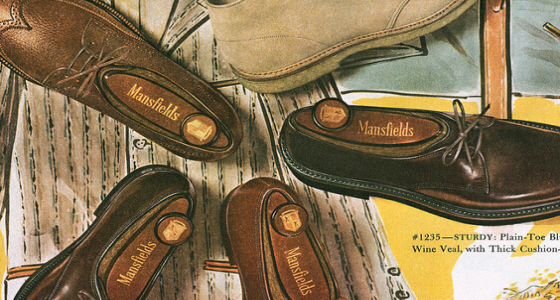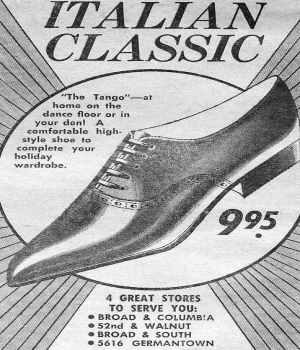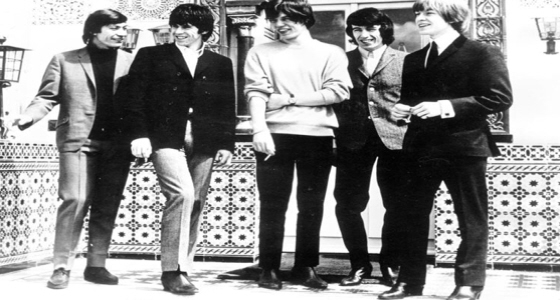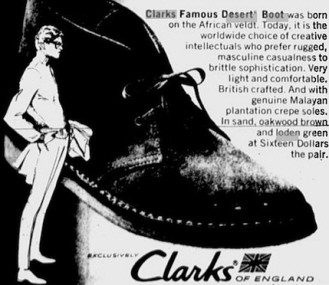
After the deeply sexual couplings of rock & roll, the '60's brought a very strange phenomenon i.e. a dance with absolutely no body contact whatsoever. Permissive society had arrived so there was no need to simulate sex within dance. Young adults adapted the rhythms of R&B and moved the 'in crowd' from dance halls to small clubs called discos. The Peppermint crowd twisted. The dance was unique and described movement from the shoes in a left and right fashion as if stubbing out a cigarette. This was co-ordinated with swinging the arms and hips as if an imaginary towel was drying the back. Clothes became more tailored and suits were the order of the day for both genders. Wrinkle pickers or needle point shoes replaced the cumbersome crepe soled shoes as hemlines rose and tights became vogue. Men sported lightweight streamlined shoes with dandy looks yet menacingly dangerous. The winklepickers were the second generation rock shoes with girls in the stilettos (high heeled pump with a sharp edge, top and tail).
 Pointed toes were a reworking of the notorious poulaines of the Middle Ages. These were outrageously phallic and distinctly male. Courtship took place on the dance floor and ability 'swing right' was caught in many of the contemporary lyrics e.g. Let's dance by Chris Montez and Twisting the Night Away by Sam Cooke.
Pointed toes were a reworking of the notorious poulaines of the Middle Ages. These were outrageously phallic and distinctly male. Courtship took place on the dance floor and ability 'swing right' was caught in many of the contemporary lyrics e.g. Let's dance by Chris Montez and Twisting the Night Away by Sam Cooke. In 1961 the champion of the Twist was Chubby Checker who wore two tone basket weave boots on stage. Between the years 1960-63 Tin Pan Alley kept cash registers filled by adhering to the tried and tested music of previous decades. Greater emphasis was placed on the electric guitar but the music stifled originality. Conventional artists wore tailored suits and patent leather shoes on stage but the beat generation in the UK was metamorphosing in the clubs and cellars of Hamburg, Germany. Women's hemlines became even shorter matching the length of men's jackets. Tight fitting bolero suits (or bum freezers) were worn by men and two piece outfits for women were accompanied with trendy pointed slip on's. Better off kids wore loafers which were the fashion of the Ivy Leaguers. Court style shoes took on in the sixties when Jacky Kennedy and Audrie Hepburn made them “the shoe.” Bought from Rene Mancini in Paris, everyone had to have a pair. Jackie K’s ordered four pairs per month but this dropped to 2 pairs after her marriage to Onassis.
By 1963 the world had gone mad for boots with Cuban heels. Lads in tight pants had buns to die for and when the Beatles adapted the tailored jacked in the German collar less style a new age teenage phenomenon followed. At first the Beatle boot were pointed but as the fashion became ubiquitous then the toes began to widen and the Chelsea boot or chisel toe became vogue. This reflected the general popularity of the Mersey Sound as it geographically moved from its parochial centre of Liverpool to the more sophisticated, metropolitan London and beyond. The Beatle Boot was less macho than its predecessors. Whilst not effeminate it was distinctly a softer less aggressive style that brothel creepers and winkle pickers. The boots often incorporated a French seem or central stitch running from ankle to toe on the upper. In the convention of symbols this referred to female genitalia rather the phallic long toes of winklepicker shoes. Beatle attire was the brainwave of manger Brian Epstein who was keen to custom the traditional stage clothing with a youthful look. Epstein had the original Beatle Boots custom made by stage clothiers and the Fab Four wore them in leather and suede.
If the Beatles were the conventional side of pop then the Stones were definitely their nemesis. Anarchy ruled, or at least so it was portrayed, and the scruffy London quintet expressed their individualism on stage by wearing clothes that suited them. Perhaps the only physical link that united the five piece band was the sneakers they wore.

Once the Mersey Sound peaked in 1964, most male singers were resigned and groomed for cabaret which left an opening for girl groups. Tights and miniskirts meant legs became the focus of attention and the longer the better. Although definitely not the first girl group the Shangri-las captured the sultry look by wearing slacks and high heeled ankle boots. Only solo female artists had the confidence to appear in miniskirts with long high heeled boots.
Jim Proby (stage name P J Proby) will probably be best remembered for his trouser splitting performances on the ill fated, English tour (1965). However his sartorial style was more a reflection of Henry Fielding's 'Tom Jones'. The bawdy adventures of the eighteenth century Jack the Lad was captured on film and Proby management was quick to cash in. Soon young men were wearing high heeled, low cut buckle shoes similar to those worn by the Sun King (Louis IVX). Just like the original style buckles fell from favour when the fashion for boots took over. Earlier P.J Proby wrote the hit 'Clown Shoes' for Johnny Brunette and might have been referring to the short lived shoe fashion he was later to be connected with. Jim Proby’s other claim to fame was before becoming solo he reputedly sang demos for the Memphis King, Old Blue Suede Shoes himself.
 But the mid-sixties exuberant youths could be divided into two rival factions: the nouveaux moderns or Mods who were followers of black music and designer clothes; and the macho rockers, or neo Ton Up boys, formerly Teddy boys. Both styles started in the fifties but now there was a critical mass of teenagers to support a dual culture. Needless to say they did not enjoy each other's company or their favourite music and took every opportunity to rumble. In England they terrorised the coastal towns with enormous running fights. As mods and rockers fought over the beaches of south coast England they wore the trademarks of their generation, i.e. boots verses shoes. Mods wore designer shoes or light dessert boots to protect their ankles from the hot exhausts of their Italian scooters; Greasers continued the sport swashbuckling styles of the earlier Ton Up boys with knee length leather boots, tight jeans, white T shirts and leather jackets.
But the mid-sixties exuberant youths could be divided into two rival factions: the nouveaux moderns or Mods who were followers of black music and designer clothes; and the macho rockers, or neo Ton Up boys, formerly Teddy boys. Both styles started in the fifties but now there was a critical mass of teenagers to support a dual culture. Needless to say they did not enjoy each other's company or their favourite music and took every opportunity to rumble. In England they terrorised the coastal towns with enormous running fights. As mods and rockers fought over the beaches of south coast England they wore the trademarks of their generation, i.e. boots verses shoes. Mods wore designer shoes or light dessert boots to protect their ankles from the hot exhausts of their Italian scooters; Greasers continued the sport swashbuckling styles of the earlier Ton Up boys with knee length leather boots, tight jeans, white T shirts and leather jackets. Few in the fashion industry could predict Mod fashions and for a short time anyway, chaos ruled in the rag trade. Youth offered a healthy group of consumers and as the sixties progressed style reflected individualism and the capital of fashion became Carnaby Street, London. The '60's Look was marketed with dedication and flair; soon the world spun into high trendy fashion.
Sandy Shaw was pop diva with a difference; she never appeared on the stage wearing in shoes. Instead she preferred to sing barefooted. Sandy had perfect feet unlike, Eve Graham from the New Seekers. Poor Eve had troublesome bunions and insisted on wearing long dresses to cover her feet. Naturally the fashion for classic long line fashion followed in the 70s.
Most young idealists followed the road to enlightenment and self discovery and many rejected materialism displaying this symbolically by going barefoot. The thong became part of the accepted outfit along with kaftans, bells, loons and Afghan coats. Woodstock, was the highest achievement of rock culture in the 60s. The cream of the pop culture were there and doing their own thing. Hippies and rockers mixed in what was three days of love, peace and music. With unpredictable weather the thong or barefoot was definitely the foot dress of choice. My own favourite Joe Cocker was there and the Sheffield tour de force sang his heart out with arguably one of the best Beatle covers, ever. He did it wearing boots decorated with a stars. Ironically Joe carried on the Beatle tradition for boots to the next decade.
The popularity of 'Easy rider` assured the urban cowboy image was legitimised and the Hollywood cowboy boot became a macho icon for ever.
Article Kippen C. 2014 Cameron K's blog Retrieved from Cameron K's Blog
http://toeslayer.blogspot.co.uk
ZANI Live Event - 5th September 2014 @ The Spice Of Life 6 Moor Street, Cambridge Circus, Soho, London W1





